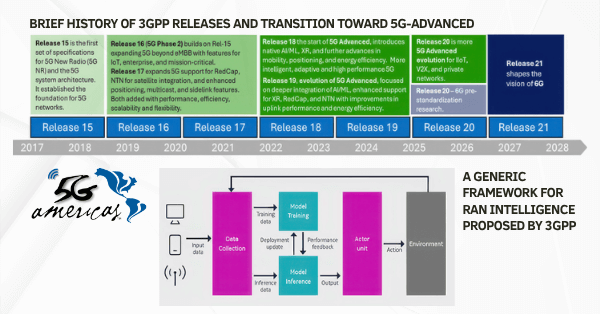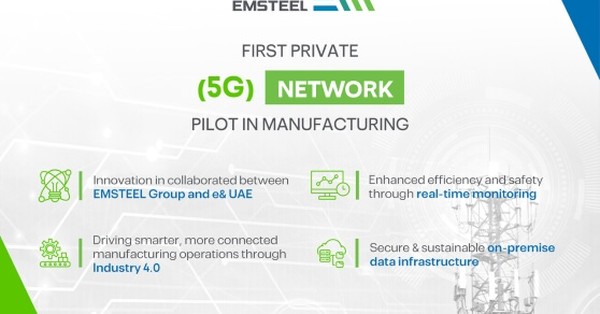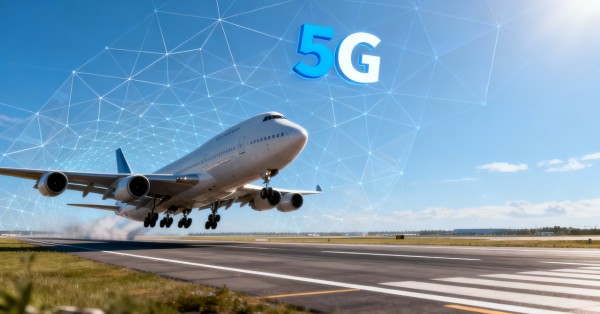5G-Advanced: More Than an Upgrade, A Foundation for What’s Next
As 5G networks mature, the demands placed on them are shifting. No longer is it enough to simply move data faster. Networks must now operate intelligently, scale efficiently, and support highly diverse use cases—from immersive consumer XR to mission-critical industrial automation and ambient IoT. This is where 5G-Advanced enters the picture.

Figure 2.1 Brief history of 3GPP Releases and transition toward 5G-Advanced (“5G-Advanced Overview“)
According to the newly published white paper by 5G Americas titled “5G-Advanced Overview”, 5G-Advanced is not just a stepping stone to 6G, it’s a major milestone in redefining how mobile networks are designed, deployed, and monetized. Built on the 5G Standalone (SA) architecture, and covering 3GPP Releases 18 through 20, 5G-Advanced enables key capabilities such as:
- AI-native networking
- Zero-touch automation
- Energy-optimized RAN design
- Latency-sensitive XR and industrial IoT support
- Non-Terrestrial Network (NTN) integration
- Private and hybrid network enablement
AI at the Core: The Rise of AI-Native Networks
What distinguishes 5G-Advanced from previous releases is the deep integration of AI and machine learning into both the Radio Access Network (RAN) and core infrastructure.
In Release 18 and beyond, AI transforms network operations through:
- Predictive maintenance that identifies faults before failures
- Intent-based orchestration enabling real-time service adaptation
- Reinforcement learning (RL) for beamforming, scheduling, and link adaptation
- Generative models for frequency tuning and idle mode balancing
Operators have reported up to 90% reduction in fault detection time, and a 70% drop in false alarms. These improvements are critical for managing increasingly complex, multi-tenant, and latency-sensitive network environments.
Additionally, AI-powered RAN optimization supports federated learning, on-device inference, and SMO-layer orchestration—key foundations for the AI-native 6G vision.
Energy Efficiency: Sustainable Networking at Scale
With RANs accounting for 80–90% of total network energy consumption, energy efficiency is a top priority in 5G-Advanced.
Key features introduced in Release 18 include:
- Discontinuous Transmission/Reception (DTX/DRX): Enables sleep states for idle cells
- Antenna adaptation: Dynamically switches antenna modes based on demand
- Conditional handover (CHO): Maintains seamless mobility even as nodes sleep
- Secondary low-power radios: Enables deep sleep and wake-on-demand for UE
These improvements result in 15–30% energy savings under typical loads and up to 56% under optimized conditions.
At the device level, ambient IoT supports energy-autonomous sensors that harvest energy from radio signals, creating a battery-less ecosystem for environmental sensing, smart cities, and industrial telemetry.
Latency, XR, and Ultra-Reliable Performance
Time-sensitive applications like extended reality (XR), robotics, and cloud gaming demand deterministic latency, reliable uplink/downlink symmetry, and advanced QoS models.
5G-Advanced introduces several innovations:
- Low Latency, Low Loss, Scalable Throughput (L4S): Queuing delay mitigation for near-zero latency
- Configured Grants and Semi-Persistent Scheduling: Enables real-time XR data transmission
- PDU Set QoS attributes and new 5QI identifiers: Aligns transport with XR traffic patterns
- Traffic-aware RRM: Predicts and reserves resources ahead of time
For industrial applications, 5G-Advanced enhances time synchronization, enabling deterministic control for mission-critical IoT systems. The result is reliable performance even under network load, essential for smart manufacturing, precision agriculture, and remote surgery.
Massive MIMO and Spectral Efficiency Improvements
5G-Advanced delivers critical upgrades to spectral efficiency via:
- Uplink MIMO (up to 8 transmission streams)
- Multi-TRP support for redundancy and latency reduction
- Higher-order modulation (1024 QAM)
- Advanced beam management with up to 128 CSI-RS ports
Current 5G networks achieve 10–80 bps/Hz using 100 MHz TDD. 5G-Advanced targets 50–400 bps/Hz over 400 MHz, with potential peak cell capacity reaching 120 Gbps in future 6G systems.
Non-Terrestrial Integration: Connectivity Beyond Borders
Expanding on Release 17’s initial support, 5G-Advanced incorporates NTNs, satellite, and high-altitude platforms into the standard mobile ecosystem.
Highlights include:
- LEO, MEO, GEO satellite integration with transparent and regenerative payloads
- Enhanced handover models for moving satellite cells
- NTN-UE categories: handheld vs. VSAT for various performance tiers
- Support for SSB periodicity adaptation and OCC in uplink
These capabilities extend 5G to cover 85% of the Earth’s surface, supporting sectors such as:
Deployment Prerequisites: What Operators Must Prepare
To deploy 5G-Advanced successfully, network operators must align their infrastructure across several key domains:
- Core and RAN upgrades: 5G SA Core is essential for features like slicing, advanced QoS, and URLLC
- Spectrum readiness: Balanced use of low (coverage), mid (capacity), and high bands (speed)
- OSS/BSS modernization: Orchestration and automation platforms that support SLA-driven services
- Device ecosystem: RedCap, XR-aware, and ambient IoT-compatible devices must be in circulation
Without this holistic readiness, operators risk underutilizing the powerful features defined in 3GPP Releases 18 through 20.
Private Networks and Monetization Opportunities
5G-Advanced significantly boosts the viability of private networks across sectors like:
With tools like:
- Dynamic slicing
- Advanced positioning
- Edge computing integration
- Network assurance and visibility
These networks deliver tailored performance and localized compute, enabling Industry 4.0 innovations such as digital twins, real-time robotics, and AI-assisted operations.
Policy and Regulation: A New Governance Model Is Needed
As AI-native, satellite-integrated networks evolve, so too must the regulatory framework. Key considerations include:
- AI/ML transparency and certification
- Zero-trust security across network slices
- Spectrum sharing and cross-border harmonization
- Lawful API access and open interface governance
- Global frameworks for ambient IoT and NTN device interoperability
Regulators must ensure trust, privacy, and interoperability without stifling innovation—a delicate but necessary balance for the 5G-Advanced and 6G era.
From 5G-Advanced to 6G: The Transition Has Already Begun
The 5G-Advanced lifecycle serves as the proving ground for 6G concepts. Between now and 2030, 3GPP is expected to finalize Releases 20–22, which will define:
- AI-native protocols and semantic communication
- Integrated sensing and control systems (ISAC)
- Ambient energy harvesting
- Three-dimensional, multi-layer connectivity across land, air, and space
Ongoing work in edge computing, cloud-native RAN, and modular architecture directly feeds into 6G design. The convergence of compute, connectivity, and intelligence will define the post-5G landscape.
Final Thoughts: 5G-Advanced as a Strategic Imperative
5G-Advanced is not just a bridge—it’s a transformation. By embedding AI, embracing sustainability, expanding coverage through NTNs, and enabling modular, real-time services, 5G-Advanced delivers a flexible and intelligent platform for future growth.
Key takeaways:
- It provides immediate ROI through automation and energy savings.
- It empowers new verticals with secure, performance-tuned private networks.
- It lays the technical and policy groundwork for 6G.
- It redefines what a network can do, not just how fast it can go.
Operators, enterprises, and regulators that invest in 5G-Advanced now are shaping the intelligent infrastructure of tomorrow.







































